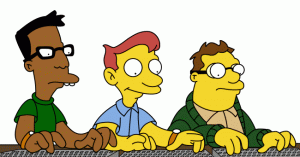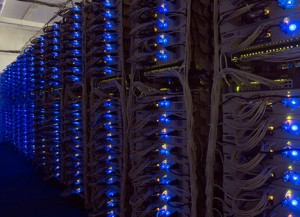Rise Of The Quant

In the business, they’re oft chided as “rocket scientists” or “propeller hats” but they’re the new archetype for a Wall St. trader. They don’t wear $5000 suites, they don’t care about the bull or the bear and they don’t even do their own trading. They spent years in academia only to leave it’s sheltered walls looking for a big day on Wall Street. Their art is called high frequency trading.
The Racket
At the heart of high frequency trading lies the same concept America’s capitalism has been hinging on for the last 200 years: buy low and sell high. More specifically, a concept called arbitrage. Arbitrage is leveraging the ability to buy something for a lower price and selling it for a higher price. Like regular investing, high frequency trading is all about information.However, instead of standing on the pillars of solid cash flow and a clean balance book, high frequency trading can work off of almost any signal: Twitter, CNN, and ongoing market pricing. Using minuscule slices of time, or perhaps a stock’s association with negative words like “loss” or “disaster”, algorithms try to deduce ‘momentum’ for any given stock. It may even be the disparity between a stocks bid and ask price. These prices determine the cheapest place to buy a stock, and the most expensive place to sell it. Stocks are then bought and sold at breakneck speed, often only holding a stock for a second to make microscopic profit. These microscopic profits are repeated ad infinitum, and a business is born. Some estimates put high frequency trading as a 20 billion dollar a year business.
The Players
Quant, short for algorithmic trading quantitative analyst is a rare hybrid of skills from many different disciplines combined into a job that up until about 10 years ago, didn’t really exist. The Securities and Exchange commission, “the federal government agency that oversees the securities markets” in the United States, set about making trades more accessible to the average consumer and decided that the best way to go about this was to lower the price per trade. In 1997 they drafted their concept on how to regulate the new largely all electronic markets. The rise of the NASDAQ, the first all electronic stock market to have any real “significant volume”, was the tipping point. (Here is the SEC’s Concept Draft.)
They work in an environment so competitive that those with capable skills are not only sought after, they’re fiercely hunted. Traditionally, they’ll have a Masters or a Doctorate in Statistics, Physics, or Mathematics. Sometimes even Financial Engineering. On top of this, they’ll possess both the chops to create algorithms designed to exploit the market, as well as the ability to program them in high level languages like C++ or Java. In all likelihood, they’ll be a member of generation X or Y, or if they’re exceptionally talented, perhaps a Millennial.

The Quant has found a place where the private sector values their highly polished academic training in their for profit world. However, the Quant is not your typical nerd. They’ll need to be highly analytical, of course, but they’ll also need to be highly creative and technical. The problem with the profession is that you’re not just fighting the fickle nature of the financial markets to make really, really tiny profits, but you’re constantly at odds with every other other Quant out there. It’s not a team sport.
In order to gain advantages over each other that are measured in magnitudes of milliseconds, sometimes they’ll write algorithms to disrupt other people playing their game, or simply to flood the market with so much data that it becomes difficult for even knowledgable observers to know what is going on, all while they’re trading their options. If it’s not malicious algorithms from other quants, or fickle markets, another problem the talented Quant faces is the availability of resources. When micro seconds make a difference, even the distance you are from the computer making your trade counts because if your competitors beat you there, literally, you’ve lost money.
The Proliferation
As the SEC continues to ignore setting rules for this sector, and more traditional players enter this realm, it will only get more competitive. Finding good talent will become harder, and the value of intellectual property will increase, creating more and more incentive to attract and keep good talent. The largest single advantage of the Quant is the high degree of specialty. As markets move even faster, and become more electronically oriented, it will only benefit the high frequency trade. You could be sitting in a financial district bar a year from now and a group of 30 somethings will walk in wearing casual clothing, talking about linux kernels — unless regulation happens, they’re the new Wall Street.
Additional Reading
http://wallstcheatsheet.com/trading-markets/trading-201/demystifying-high-frequency-trading.html
http://www.nytimes.com/2011/01/02/business/02speed.html?pagewanted=1&_r=1&hpw
http://www.nanex.net/20100506/FlashCrashAnalysis_Part1-1.html
